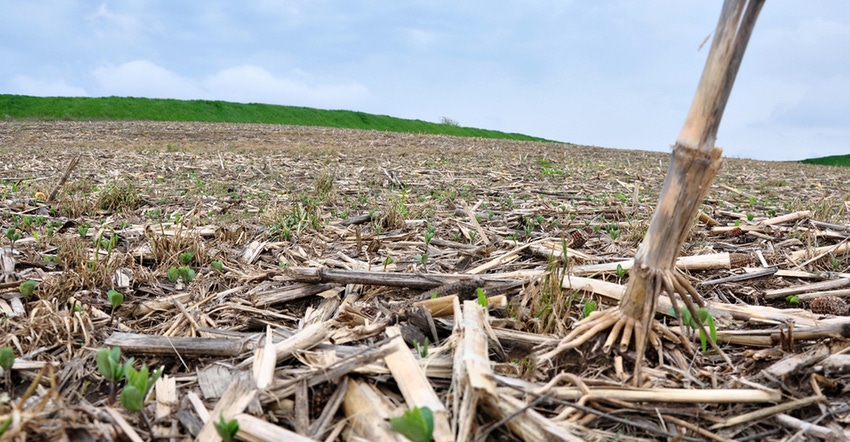March 6, 2019

Last fall was challenging. It started with rainfall beginning in early September as the corn and soybean crop was maturing. While most farmers were eventually able to finish harvesting last fall, rain and cold temperatures limited fall tillage operations. This presents an opportunity to save money on input costs this spring.
Soybeans don’t have a yield response to tillage. That’s good news. There is no need to spend time, labor and fuel incorporating corn residue to plant soybeans. Also, spring tillage operations aren’t effective for breaking up soil compaction. In fact, the opposite happens in normal spring conditions when soil moisture is plentiful. Spring tillage in wetter conditions leads to smearing of soil from the tillage knives or sweeps, and disking creates a compaction layer while sizing residue.
There may be a need for some spot tillage to fill ruts created during harvest. This should be limited to the field areas with ruts. Shallow tillage is adequate. Deep tillage will likely not reach the full depth of compaction, and because of spring soil moisture, will make the compaction problem worse.
Focus on planter performance
This spring more farmers will be trying no-till, some for the first time. Keep in mind that the essential step to success with no-till planting is to ensure proper function of the planter. This isn’t different from any other tillage system. Confirm that you have the appropriate row-unit down pressure, check seed placement depth, and ensure furrow closure. No-tilling corn and soybeans does require more finesse, but with some patience at planting time, it will provide dividends at harvest.
To avoid planting problems with no-till, make sure the equipment on your planter is working properly before you go to the field, and then regularly check the planter’s performance in the field. In many cases, problems with no-till can be traced back to poor planter performance.
Planting situations
Here are three planting situations for spring:
No-till planting soybeans. I’ve talked to farmers who have experience with no-tillage planting. It’s unanimous that any planter purchased in the last 20 years can plant soybeans into corn residue without any trouble, especially if the planter already has row cleaners. Nearly all planters have the ability to ensure appropriate down pressure and seed depth placement.
Research across Iowa shows soybean yield is not influenced by the tillage system. Thus, no-till planting soybeans into corn residue will produce yields similar to other tillage systems and will result in higher economic returns.
Planting corn into bean residue. When planting corn into soybean residue, you don’t have as much residue to deal with, but there are other considerations. Since bean residue is fragile and less abundant than corn residue, today’s planters can easily move through fields with little or no reduction in typical planting speed. Row cleaners should be set to “tickle” the soil which will easily move soybean residue out of the row.
Using injected spring nitrogen to prepare a seedbed — similar to using strip-tillage — is a good option. But the N should be injected seven to 14 days ahead of planting, and ideally, you’ll want to have a gentle rain after the injection to avoid the burning of corn seedling roots by the N.
Planting corn into corn residue. Planting corn into corn residue is more complicated than planting no-till corn into bean residue. In this situation, light tillage, such as using a rotary harrow or a vertical tillage implement, may be necessary. It’s important to use row cleaners to move corn residue out of the row. Having the ability to use starter fertilizer can also help lessen early-season growth challenges often associated with corn following corn.
If fall anhydrous application was delayed until spring, using an RTK guidance system can effectively form a tillage zone to plant into, similar to strip tillage. If you are doing this, be cautious of high nitrogen rates burning corn seedling roots. Waiting seven to 14 days between anhydrous application and planting (and receiving a gentle rain) along with injecting the N slightly deeper than usual can reduce potential seedling burn issues.
4 tips for no-till planting
Check out this advice for successful no-till planting:
Wait for soil conditions to be fit for planting before pulling into the field.
Like any new practice, start slowly with no-till to gain confidence then increase the planting speed.
Set row cleaners to move crop residue but not make a trench.
Check planter performance and seed placement often.
Licht is the Iowa State University Extension cropping systems agronomist. Contact him at [email protected].
About the Author(s)
You May Also Like






